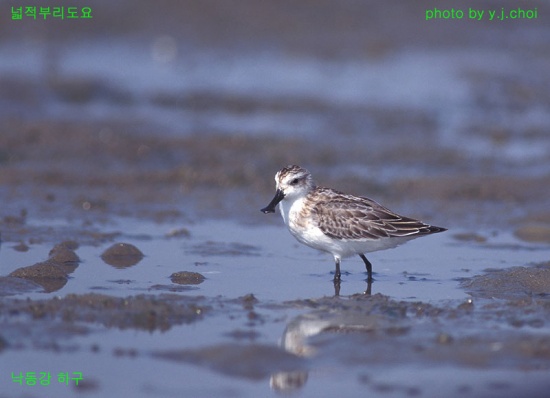| This article is a stub. This article is short and lacking information. You can help the BirdForum Opus by expanding it. |
- Eurynorhynchus pygmeus
Identification
The Spoon-billed Sandpiper Is a small peep with a unique spatulate-shaped bill. The breeding adult has a rufous head, neck, and chest, with a white underbody and white-outlined black feathers on the upperbody. The Juvenile lacks the reddish coloration of the adult, but has white coloration instead with a dark "cheek" and crown. The plumage of this sandpiper is almost exactly like the Red-necked Stints, but can be separated from this peep by the different bill-shapes and darker auriculars and a more sharply defined supercilium on the juvenile Spoon-billed. But the strange bill shape can be hard to see from a distance and some sandpipers with mud stuck on the bill tip can look as though they have the spoon shape. The average size of the adult Spoon-billed Sandpiper is six inches (about fifteen centimeters).
Distribution
The Spoon-billed Sandpiper is a rare bird and highly endangered. The global populationis low, estimated av=bout 1,000 breeding pairs. They breed in Northeast Russia. In migration and winter they are rare, and are found on the east coast of asia as far south as the Phillipines. There have been a few records of the Spoon-billed Sandpiper in North America; around five in western Alaska and one breeding adult in British Columbia.
Taxonomy
Linean Classification of the Spoon-billed Sandpiper
'Class': Aves- All bird species
Order: Charadriformes-One of the largest non-passerine bird orders and is very diverse. Contains three suborders: Lari- the Gulls, Skuas, and Terns; Alcae- Puffins and Auks; and Charadrii- The waders and shorebird families
Suborder: Charadrii- All waders; the plovers, oystercatchers, stilts, avocets, curlews, peeps, snipes, etc
Family: Scolopacidae- Large family of waders, commonly known as sandpipers
Subfamily: Calidrinae- The peeps and stints; small, stocky, thin-billed sandpipers
Genus: Eurynorhynchus
Species pygmeus
There are no known subspecies of the Spoon-billed Sandpiper.




